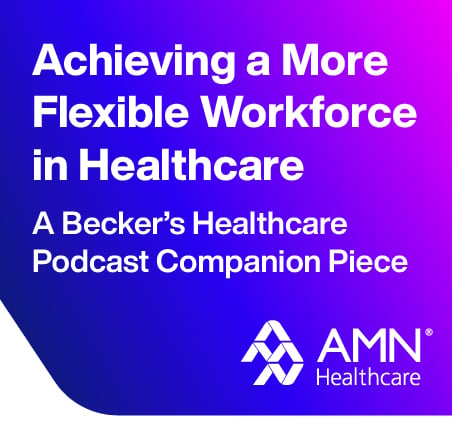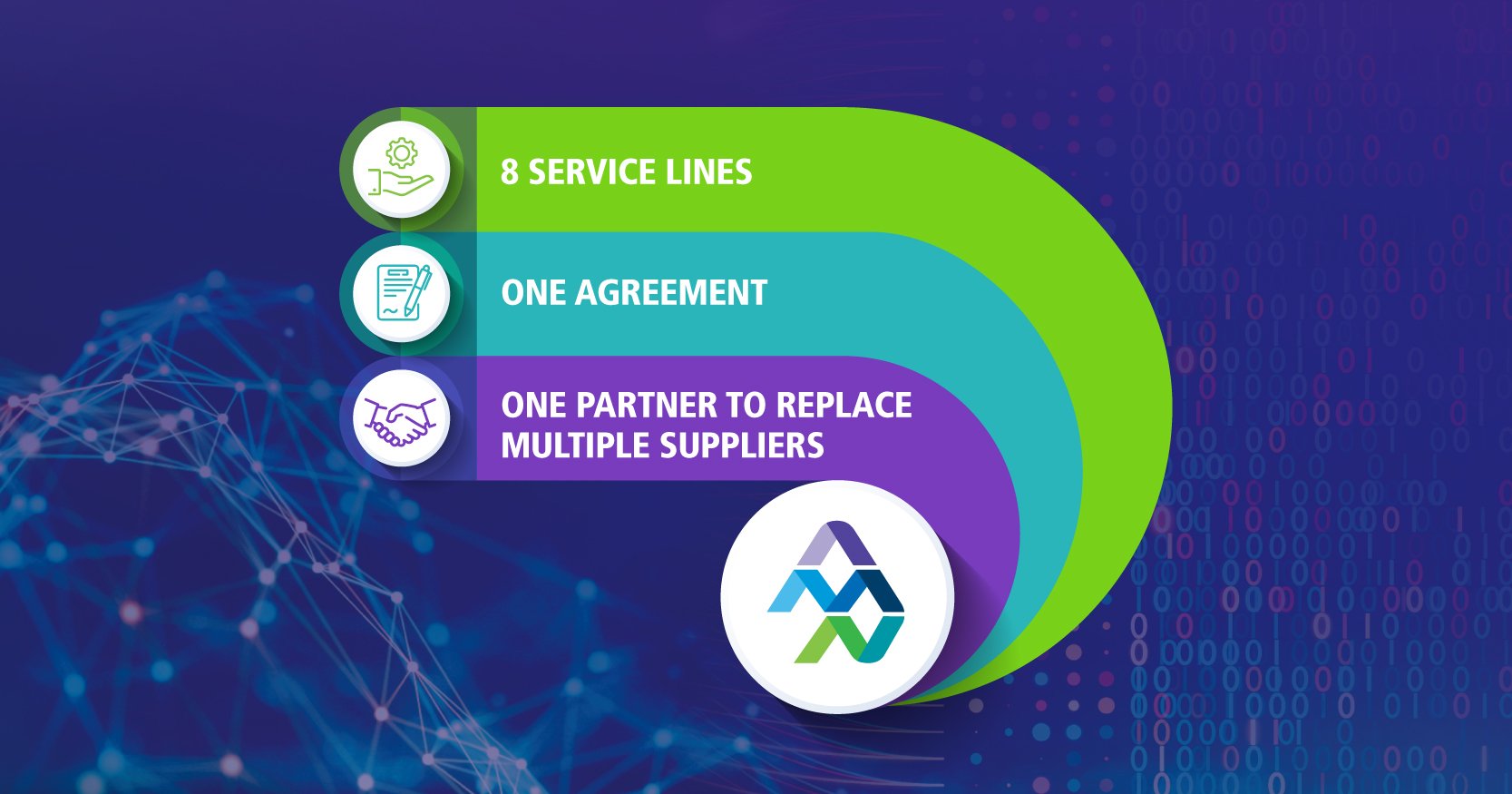
The Evolution of Organizational Healthcare Workforce Management
Part 1 of 3
According to Steven Endsley, regional vice president of strategic talent solutions for AMN Healthcare, the COVID-19 pandemic has challenged provider organizations to reevaluate long held beliefs on how to ensure the delivery of care to their communities.
Prior to the pandemic, working in hospitals meant 8- or 12-hour shifts, every other weekend plus a minimum number of holidays. Options included full-time, part-time, and limited per diem.
Endsley notes that significant trends projected to unfold in the next ten years are already occurring, such as the demand for healthcare and healthcare providers, and the shift in how healthcare is delivered. Hospitals and health systems must expedite their future workforce strategies, remaining focused on delivering quality patient care while reducing clinician burnout and costs.
In this three-part series, Endsley explores fundamental steps to optimizing the workforce of today while creating the workforce of tomorrow through stronger internal and external partnerships.
Q: How does healthcare’s workforce management structure align with the Institute for Healthcare Improvement’s Quadruple Aim?
Endsley: As hospitals and health systems establish strategies and operating plans to align with the Quadruple Aim, the current environment has escalating workforce costs and high vacancy rates limiting access to care for many and creating stressful work environments. There is increasing polarity between the four aims, impacting workforce management. The pandemic played a contributory role as it has further complicated workforce dynamics. For instance, healthcare organizations today face a greater risk of misalignment when balancing the need to reduce costs while ensuring a positive experience for clinicians and patients. At the same time, provider organizations tend to make decisions across multiple, siloed departments that lack a holistic understanding of the impact these choices may have on each area of the Quadruple Aim.
Q: Why must healthcare organizations consider an alternative workforce management model in the current state?
Endsley: The answer lies in the rapidly changing workforce. According to Forbes, Millennials are on the verge of becoming an overwhelming majority in the workforce (75 percent by 2025). 1
As noted in the AMN Healthcare 2021 Survey of Registered Nurses, nearly one-quarter of nurses, or 23% of nurses surveyed said they likely will quit their job because of burnout and a high-stress working environment as a result of the COVID-19 pandemic. Approximately one million registered nurses will retire by 2030.2

These shifts indicate it is time to adopt a new workforce management model prioritizing flexibility, retention, clinician satisfaction, continuity of care, and financial stability. Throughout one’s career lifecycle, there are different priorities; stability and structure, flexibility to meet family needs, or variety to use skills in new ways and in new settings. To retain employees, these options must be available and attractive. New workforce models must also be financially sustainable for healthcare organizations. Today, hospitals are facing daunting financial challenges. One of the components leading to those challenges is the cost of the workforce. By building more layers to your workforce, at different costs, and utilizing a technology to predict staffing needs, hospitals can ensure they have the right staff, at the right time at the right cost.
Q: Which areas of the healthcare organization need to align more closely to ensure the future success of workforce management?
Endsley: To ensure a coordinated approach to workforce management, clinical, finance, HR and IT must align and work in unison. Often finance, clinical and HR are working from different technology systems that provide data through a different lens, leading to frustration when one department reports they are understaffed, yet another model shows they have the staff needed. IT has become a critical component, but they too have workforce challenges and have limited capacity to integrate new technologies that could lead to greater access to care or process efficiencies. It is imperative that the departments have a shared vision and work together within a center of excellence to understand how their decisions impact other areas and align with the bigger picture. Our ultimate goal in working with our clients is to create a more collaborative approach and provide the tools that support the vision.
Q: What best-practice models have been deployed in health systems nationwide?
Endsley: We’ve witnessed some of our health system partners, who are leaders in the industry, offer innovative workforce opportunities that improve the employee experience, leading to better patient outcomes. These organizations have even created internal contract labor functions to engage their workforce more strategically, especially in the wake of the high turnover from the pandemic. They are adding flexible labor programs beyond the traditional float pool model, including gig-economy-inspired flexible scheduling, internal agencies, virtual care delivery and international clinicians. To build a successful workforce for the future, we believe organizations must adopt this type of flexibility.
- Timmes, M. (2022). Millennials and Gen Z: Now is the time to reshape businesses to harness their power. Forbes. https://doi.org/June 27, 2022.
- "AMN Healthcare 2021 Survey of Registered Nurses." pgs. 13 and 31. 2021. AMN Healthcare website. Accessed 27 Mar. 2023.
Learn More About our MSP Programs
Latest News
AMN Healthcare’s Interactive 2025 Solutions Overview eBook
By combining innovative technology, an extensive network of clinicians, and unparalleled expertise, we help healthcare organizations overcome workforce challenges.
The Difference Between MSP and VMS and How They Work Together in Healthcare
Explore the differences between two crucial components that play a significant role in achieving healthcare organization goals, Managed Service
Can a Staffing Company Truly Offer Vendor-Neutral MSP Services?
Healthcare organizations face increasing challenges in balancing cost-efficiency with high-quality patient care. Vendor-neutral Managed Services Providers (MSPs) offer a critical solution—
What is a VMS in Healthcare and What Can It Do?
A Vendor Management System (VMS) is an internet enabled application that organizations use to procure staffing services from third party staffing suppliers.
What is an MSP in Healthcare?
A Managed Services Provider (MSP) helps healthcare organizations manage their temporary workforce by acting as an outsourced service that organizes and oversees these staff members.
Insights from Industry Leaders to Enhance Healthcare Workforce Well-being
Healthcare is at a pivotal point where addressing workforce challenges is crucial for sustaining quality care and operational efficiency.
Unlocking Workforce Potential: 6 Strategic Advantages of Partnering with a Consultative Managed Services Provider
Partnering with a consultative Managed Services Provider (MSP) is key to achieving this balance, as they bring the expertise to optimize your workforce strategy, reduce costs, and align
Transparency Equals Trust: The Power of Transparency in Healthcare MSPs
At AMN Healthcare, we recognize that earning and maintaining our clients' trust requires clarity and openness at every step of our engagement.











